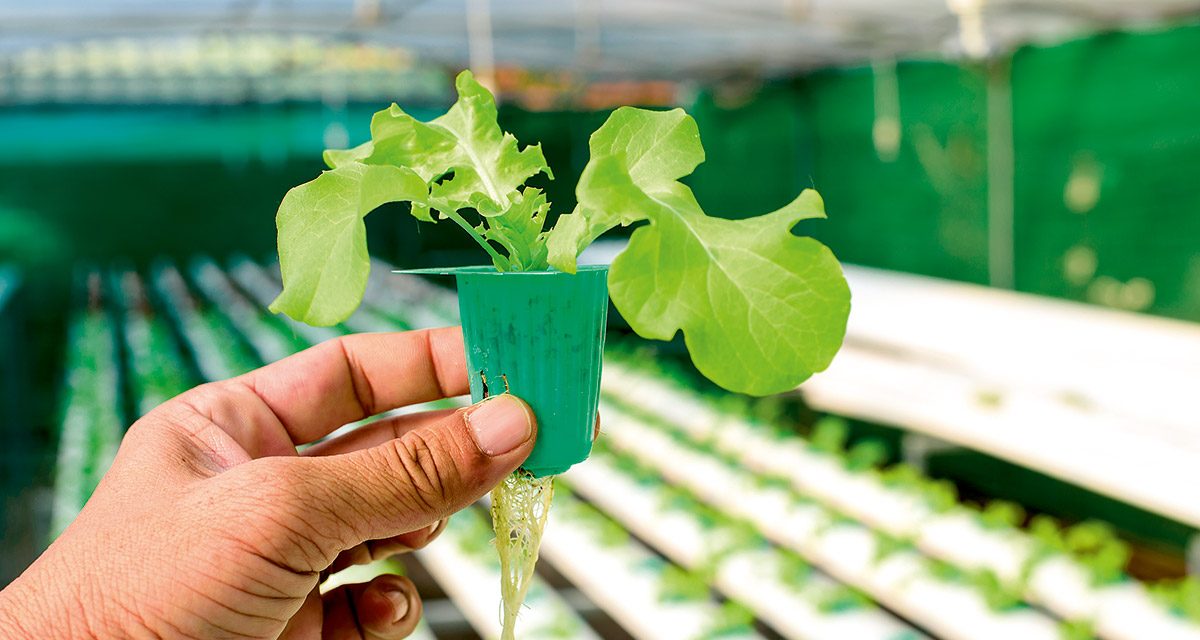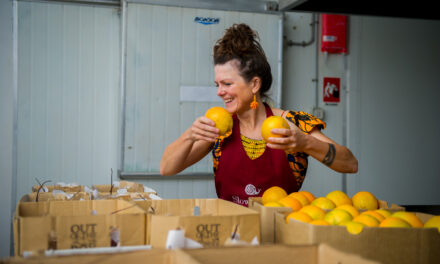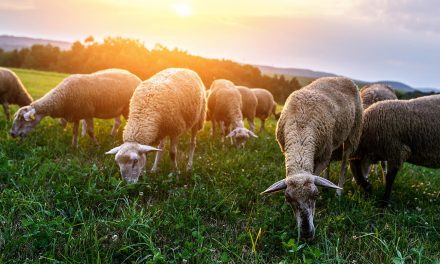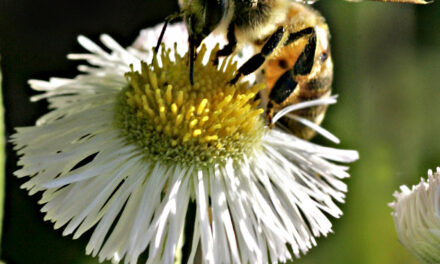An enduring drought and the prospect of losing his garden due to water shortages, aquaponics advocate and expert Murray Hallam found a way to grow fruit, vegetables and even fish in a simple system that can be set up in backyards, on balconies and beyond.
It’s called aquaponics and for a dry country like Australia, he believes it can revolutionise the way we grow food in the future.
Murray is one of Australia’s leading aquaponics experts, having entered the industry a decade ago.
‘’It is a little over 10 years ago that I discovered aquaponics and I have to admit it has been an obsession ever since. I have been fortunate enough to travel across Australia and America visiting farms and helping set up home aquaponics systems as well as delivering training to commercial and private enthusiasts,’’ he says.
‘’It is most inspiring to be involved in a new fledgling industry that has the capacity to deliver food purity and food security to all.’’
Murray grows all sorts of vegetables, fruit and protein in the system, including tomatoes, eggplants, chillies and lettuce, as well as fruit, fish and crustaceans. “You name it, we can grow it,’’ he says.
He claims that he can grow a lettuce in just 21 days, a dinner plate-sized fish in just six to nine months and even tropical paw paw in ‘’just gravel and fish poo’’.
‘’We’ve harvested nearly 40kg of fruit from two trees,’’ he adds.
‘’What’s even better is that the system can be set up anywhere, on a balcony or in a backyard.
‘’The best part about aquaponics is that it uses only 10 per cent of the water that you would use to grow the same number of veggies in a traditional garden. The only water it loses is what the plants transpire. The rest of the water just keeps circulating. That was what initially amazed me; that I could grow my produce with only a tenth of the water,’’ Murray says.
The system has a very low environmental footprint and replicates nature. According to Murray, it is similar to what happens in a healthy river system.
‘‘In my system, fish are grown in tanks and they produce waste. This waste water is pumped from nearby tanks to the grow beds, which contain the plants, and back again every 12 minutes. Fish waste is then broken down by naturally occurring and beneficial bacteria on gravel, which is what the plants are grown in. Garden worms in the grow beds also help break down the waste into nutrients and other minerals and make it available to the plants,’’ he explains.
Murray believes it is possible to grow any type of freshwater fish or crustacean, as well as some salt water varieties, in an aquaponics system.
“At the moment I have jade perch, silver perch and barramundi, but you can also grow Murray cod and trout, in the southern states. My tanks are an average of 1m deep by 1.5m wide and 1.5m high.’’
Another advantage of the system is that it is ‘clean and green’.
“The unit is completely self-contained. We can’t use any insecticides because if we do, we kill the fish. Any type of poison or even artificial fertiliser in the water will kill the fish in half an hour. You are forced to be organic whether you like it or not,’’ he says.
For families, Murray believes aquaponics is a ‘’practical and inexpensive way to feed the family, once set up and with a little know-how’’. He says there are two ways to go about setting up an at-home aquaponics system.
‘’You can either buy a ready-made system or you can do it yourself and so many people opt to do it themselves. The components you’re going to need is a fish tank and some kind of gravel grow bed to provide the bed part of it and we’d need a water delivery system, so that consists of a pump and some pipe work that brings the water from the fish tank into the gravel grow bed and then we need to return the water from the gravel grow bed which is what this componentry’s about – back into the fish tank.’’
Growing fish and vegetables together has long been popular in parts of southern China, Thailand and Indonesia in a unique and sustainable approach to farming – and where space has been limited.
Aquaponics combined with a climate-controlled environment such as a greenhouse, can produce food year-round.
Aquaponics systems used by the backyard grower can vary in size, anywhere from a small fish tank to the whole backyard. A greenhouse is not essential; however, it does provide enormous protection for the system compared to being exposed to the elements.
‘’If you live in an area where it gets cold during winter, a greenhouse is needed for the protection of the fish and plants during the colder months. Aquaponics systems can also be set up indoors, using grow lights over the plants instead of using sunlight but this system uses more power than a greenhouse system due to the cost of running the lights,’’ notes Murray.
Today, there are three main styles of aquaponics system designs, including:
- Media Based: these systems see plants directly sewn into gravel or expanded clay pebbles. The grow beds are usually flooded and drained periodically, allowing water to circulate through the system on a regular basis.
- Deep Flow / Raft: long channels hold water at a depth of about 30-40cm while boards made from styrofoam or plastics float on top of the water. Holes are drilled into the boards, and net pots are fitted. Plants are either sown directly into the net pots, or transplanted from another growing area. The plants grow with their roots always immersed in the long channels of water below the boards.
- NFT (Nutrient Film Technique): NFT systems are the least used in Aquaponics, due to their high-maintenance requirements, including expensive filtration systems needed. Plants hang in net pots and a small amount of water is run along the base of the channel where the plants roots can access it.
Studies into the types of plants that can be grown in an Aquaponics system most successfully have shown that leafy green vegetables, vine plants, fruit and fruit trees, flowers and fodder do best. The cost and turnover time of each crop varies dramatically, with leafy greens able to be produced in a few months, while root-based plants and fruit trees take much longer.
Barramundi, silver perch, trout, golden perch, catfish, Murray cod, jade perch, Australian bass, black bream, eels and yabbies are legal to own and grow in aquaponics systems in Australia. The type of fish that are being grown will determine the type of fish food that is used.
‘’The more fish in a system, the more nutrients there are for the plants to consume, but if there are not enough plants to consume these nutrients, the excess build-up in the water can cause the fish to suffer. As a general rule, backyard systems can stock between 10-30kg of fish per 1000 litres of water,’’ says Murray.
‘’Tanks used to house the fish can be made from any kind of water reservoir that is clean, and has preferably never held chemicals. This is especially important for plastic tanks, which can retain the chemical residue in its structure, and release it into the water slowly which can lead to the fish becoming sick or even killed by the leaching poison. The cleaner the original set-up of the system, the more likely you are to have a hassle-free aquaponics system for the long term.
‘’Ensure tanks are covered from direct sunlight by using a lid. Any direct light that gets into the tank will cause algae to grow, which takes away nutrients from the plants. Fish need just a little light so that they can see whether it is day or night, and keeps their natural rhythms in check,’’ he adds.
After the initial set-up, aquaponics systems are relatively low maintenance. Key ongoing tasks include feeding the fish, harvesting crops or planting, periodic cleaning, water testing, disease and pest monitoring and prevention.
There are no permits needed in Australia to set up a backyard aquaponics system.
Murray’s Tips:
• It is possible to set-up your own aquaponics system quite cheaply – for under $1500. Murray sells Do It Yourself kits, which range in price upwards of $995.
• Before setting up an aquaponics system do some research. Murray says that the first six weeks are critical and if you haven’t got your system set-up correctly the fish will die.
• You don’t need much room, but you need at least six hours of sun to grow a good crop of vegies.
• Start with leafy greens, such as lettuces and silverbeet. Root vegies can be grown but are more difficult.
For more information phone
Murray Hallam’s Practical Aquaponics on (07) 3200 0272 or visit www.aquaponics.net.au








